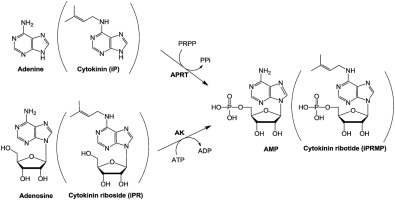当前位置:
X-MOL 学术
›
Phytochemistry
›
论文详情
Our official English website, www.x-mol.net, welcomes your
feedback! (Note: you will need to create a separate account there.)
Purine salvage in plants
Phytochemistry ( IF 3.2 ) Pub Date : 2018-03-01 , DOI: 10.1016/j.phytochem.2017.12.008 Hiroshi Ashihara , Claudio Stasolla , Tatsuhito Fujimura , Alan Crozier
Phytochemistry ( IF 3.2 ) Pub Date : 2018-03-01 , DOI: 10.1016/j.phytochem.2017.12.008 Hiroshi Ashihara , Claudio Stasolla , Tatsuhito Fujimura , Alan Crozier

|
Purine bases and nucleosides are produced by turnover of nucleotides and nucleic acids as well as from some cellular metabolic pathways. Adenosine released from the S-adenosyl-L-methionine cycle is linked to many methyltransferase reactions, such as the biosynthesis of caffeine and glycine betaine. Adenine is produced by the methionine cycles, which is related to other biosynthesis pathways, such those for the production of ethylene, nicotianamine and polyamines. These purine compounds are recycled for nucleotide biosynthesis by so-called "salvage pathways". However, the salvage pathways are not merely supplementary routes for nucleotide biosynthesis, but have essential functions in many plant processes. In plants, the major salvage enzymes are adenine phosphoribosyltransferase (EC 2.4.2.7) and adenosine kinase (EC 2.7.1.20). AMP produced by these enzymes is converted to ATP and utilised as an energy source as well as for nucleic acid synthesis. Hypoxanthine, guanine, inosine and guanosine are salvaged to IMP and GMP by hypoxanthine/guanine phosphoribosyltransferase (EC 2.4.2.8) and inosine/guanosine kinase (EC 2.7.1.73). In contrast to de novo purine nucleotide biosynthesis, synthesis by the salvage pathways is extremely favourable, energetically, for cells. In addition, operation of the salvage pathway reduces the intracellular levels of purine bases and nucleosides which inhibit other metabolic reactions. The purine salvage enzymes also catalyse the respective formation of cytokinin ribotides, from cytokinin bases, and cytokinin ribosides. Since cytokinin bases are the active form of cytokinin hormones, these enzymes act to maintain homeostasis of cellular cytokinin bioactivity. This article summarises current knowledge of purine salvage pathways and their possible function in plants and purine salvage activities associated with various physiological phenomena are reviewed.
中文翻译:

植物中的嘌呤回收
嘌呤碱基和核苷是通过核苷酸和核酸的转换以及一些细胞代谢途径产生的。S-腺苷-L-甲硫氨酸循环释放的腺苷与许多甲基转移酶反应有关,例如咖啡因和甘氨酸甜菜碱的生物合成。腺嘌呤由蛋氨酸循环产生,这与其他生物合成途径有关,例如用于生产乙烯、烟胺和多胺的途径。这些嘌呤化合物通过所谓的“补救途径”被回收用于核苷酸生物合成。然而,补救途径不仅是核苷酸生物合成的补充途径,而且在许多植物过程中具有重要功能。在植物中,主要的补救酶是腺嘌呤磷酸核糖转移酶 (EC 2.4.2.7) 和腺苷激酶 (EC 2.7.1.20)。这些酶产生的 AMP 转化为 ATP 并用作能量来源以及核酸合成。次黄嘌呤、鸟嘌呤、肌苷和鸟苷通过次黄嘌呤/鸟嘌呤磷酸核糖转移酶 (EC 2.4.2.8) 和肌苷/鸟苷激酶 (EC 2.7.1.73) 回收为 IMP 和 GMP。与从头嘌呤核苷酸生物合成相反,通过补救途径的合成对细胞非常有利,在能量上。此外,补救途径的运作降低了抑制其他代谢反应的嘌呤碱基和核苷的细胞内水平。嘌呤补救酶还催化从细胞分裂素碱基和细胞分裂素核糖苷分别形成细胞分裂素核糖苷。由于细胞分裂素碱基是细胞分裂素激素的活性形式,这些酶的作用是维持细胞分裂素生物活性的稳态。本文总结了目前关于嘌呤回收途径的知识及其在植物中的可能功能,并对与各种生理现象相关的嘌呤回收活动进行了综述。
更新日期:2018-03-01
中文翻译:

植物中的嘌呤回收
嘌呤碱基和核苷是通过核苷酸和核酸的转换以及一些细胞代谢途径产生的。S-腺苷-L-甲硫氨酸循环释放的腺苷与许多甲基转移酶反应有关,例如咖啡因和甘氨酸甜菜碱的生物合成。腺嘌呤由蛋氨酸循环产生,这与其他生物合成途径有关,例如用于生产乙烯、烟胺和多胺的途径。这些嘌呤化合物通过所谓的“补救途径”被回收用于核苷酸生物合成。然而,补救途径不仅是核苷酸生物合成的补充途径,而且在许多植物过程中具有重要功能。在植物中,主要的补救酶是腺嘌呤磷酸核糖转移酶 (EC 2.4.2.7) 和腺苷激酶 (EC 2.7.1.20)。这些酶产生的 AMP 转化为 ATP 并用作能量来源以及核酸合成。次黄嘌呤、鸟嘌呤、肌苷和鸟苷通过次黄嘌呤/鸟嘌呤磷酸核糖转移酶 (EC 2.4.2.8) 和肌苷/鸟苷激酶 (EC 2.7.1.73) 回收为 IMP 和 GMP。与从头嘌呤核苷酸生物合成相反,通过补救途径的合成对细胞非常有利,在能量上。此外,补救途径的运作降低了抑制其他代谢反应的嘌呤碱基和核苷的细胞内水平。嘌呤补救酶还催化从细胞分裂素碱基和细胞分裂素核糖苷分别形成细胞分裂素核糖苷。由于细胞分裂素碱基是细胞分裂素激素的活性形式,这些酶的作用是维持细胞分裂素生物活性的稳态。本文总结了目前关于嘌呤回收途径的知识及其在植物中的可能功能,并对与各种生理现象相关的嘌呤回收活动进行了综述。











































 京公网安备 11010802027423号
京公网安备 11010802027423号